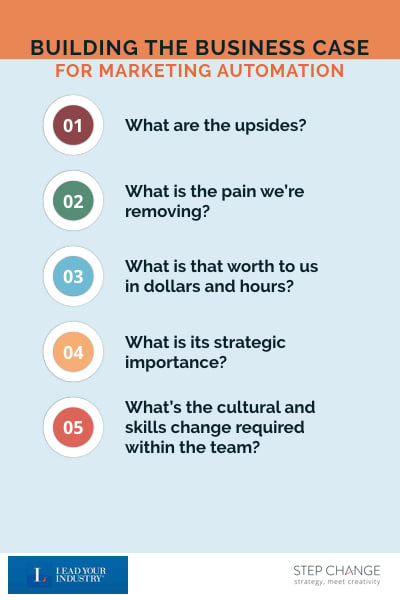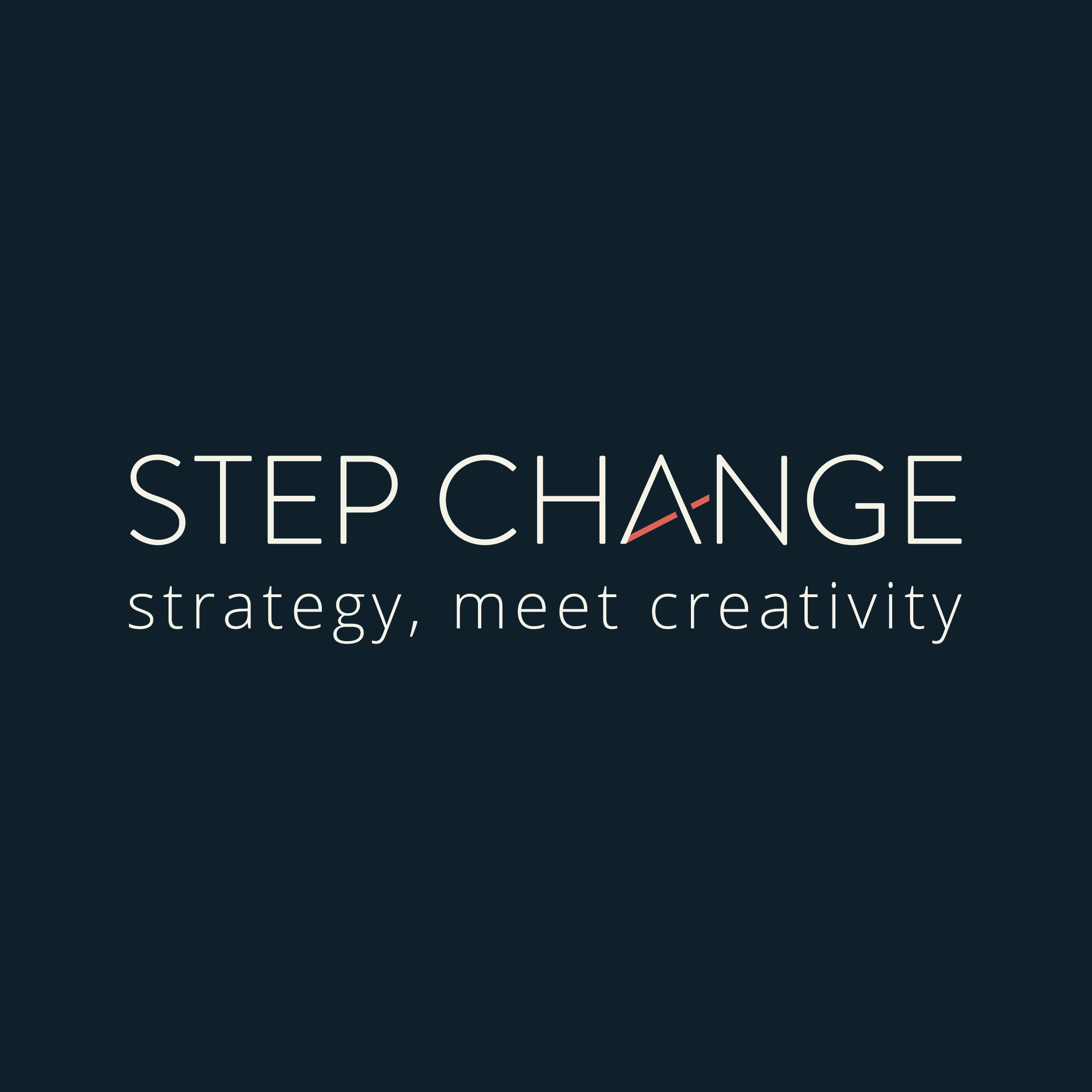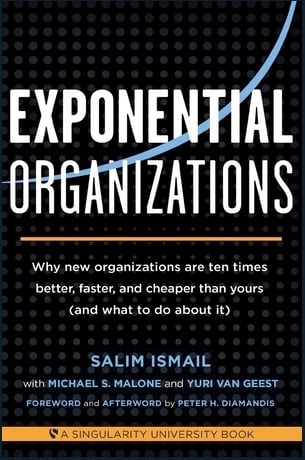If marketing automation is a great tool for businesses, how do we build an airtight business case for it? And how can we get our stakeholders and the sales team on board?
Jeff Cooper, Founding Partner at Step Change, sits down with Anthony Moss, CEO at Lead Your Industry, to explore the answers.
Insight: Closing deals requires an alignment between marketing and sales, and this can be achieved with marketing automation, which creates effective collaboration and communication across the departments.
Data: Businesses who use marketing automation experience 25% better revenue attainment vs non-users. (Marketo)
Key Action Point: Learn how to put together a business case for marketing automation that will get you buy-in from sales and the executive management.
Contents
- Marketing Automation Is Relevant for Sales
- Why Use Marketing Automation to Increase Sales?
- Building the Business Case for Marketing Automation
- Conclusion
Marketing Automation Is Relevant for Sales
Almost every conversation around strategy and growth inevitably comes down to return on sales and marketing. People are searching for the levers that will work. And we know that when it comes to marketing, the levers are changing all the time.
When it comes to B2B sales, the conversations are still the same: people still buy from people, to a large measure, so there is definitely a role for a face-to-face exchange.
But the exchange we see today is different than it has been. It’s no longer about information sharing. Nobody needs a salesperson to deliver information today. The information is readily available on the web.
But the need for salespeople is still there. It’s very expensive for an organisation to have a transactional one-to-one relationship with clients unless they’re selling hugely expensive capital goods.
The opportunity for salespeople is to focus on strategic account management with ideal customers, new customer acquisition and so on. This is where marketing automation for sales teams can play a massive role. This is true to both internal and external sales.
It increases the leverage of all the sales resource because it’s all about communicating with people when they’re ready to buy. In our experience across the whole range of industries within my work, the whole push strategy just doesn't work. It’s no longer relevant.
No CEO or any senior leader wants to be sold to and pushed to. They want to be engaged in that journey themselves. Automation has the potential to add value to that process and increase the leverage and the return on investment both internal and external sales.
Why Use Marketing Automation?
Be Top of Mind
Marketing automation keeps you and your brand in front of your sales prospects when you can’t be there physically. This is relevant whether you are a brand serving locally or planning on expanding internationally.
Engage with Different Types of Customers
We also see the value of automation in the ability to sell beyond just the A and B class customers. There are other types of customers who want to buy from you as well, and you might be happy to sell to them.
Automation can keep you engaged with these types of customers and therefore increase return on your sales effort.
Ensure Quality Leads
Today’s buyers tend to research and compare products on their own before contacting a salesperson. Marketing automation ensures your sales team that when they do face-to-face interactions, it is with prospects that are warm and receptive.
Allow the Organisation to Own the Information
Automation in sales gives management the ability to shift from dependence on the old-style “relationship alchemy” that a salesperson may have. With automation and tracking, that information shifts from being owned by the salesperson to being owned by the organisation, which is a key challenge for any organisation but particularly for SMEs.
Have Pipeline Visibility
Automation also allows you to have high visibility around pipeline management, which is the goal for every organisation.
Management has access to that invaluable information in addition to the salesperson. Leaders can interrogate that data, look at the value and volume of customer interactions, and therefore validate the value, the volume, and the visibility of marketing. Of course, any system is only as good as its ease of use, how visible the information is, and how the information is utilised.
Ensure Speed of Response
We have worked with many clients where we have determined that — while they may have very clear value propositions around their product or service, best quality, service, best price, and so on — it’s the speed of response that has a massive impact on the buying decision.
Handpicked article: Why Your Sales Team Need Marketing Automation and Content Marketing
What we’ve mentioned above are the benefits of having a marketing automation working for your team. If you’re considering adding one in your arsenal to close more deals, here are crucial and actionable points you need to know.
Building the Business Case for Marketing Automation
1. Look at Marketing Automation with a Strategic Lens
For leaders who are still investigating if automation is right for their business, here is a crucial reminder for you.
Automation is a strategy-first situation. You need to stop looking at it as a tactic because it’s more than that. It requires a complete business model transformation.
To put in any form of automation in any way that’s going to make any impact is a strategic business-wide decision based upon a tangent business model. It will affect everyone in the organisation. It will impact human resources, how you hire, how you fire, your IT capabilities, your marketing department, and your leadership.
We find, often, when leaders talk about the challenges that automation can fix, they think this is a marketing issue. They try to treat it and solve it like it’s a marketing issue.
They’d set a test budget, look for quick wins over 90 days, give it to whoever has “marketing” in their title without necessarily really looking at how it’s going to impact all stakeholders in the business.
Fundamentally, they treat it in a diminutive way and then get a diminutive result. They treat it as this little thing that’s going to help some people, and then they wonder why it doesn’t get traction, support, and investment.
It’s important to remember that it will take several years to see the returns. In fact, one study revealed that in six months of using marketing automation, only 8% of the companies surveyed saw positive results. But after one year, 32% of companies reported an increase in revenue. In two years, the figure increased to 40%.
So if your organisation has a business plan, automation needs to be one of your strategic pillars or key initiatives.
2. Determine the Business Drivers
Before deciding to put any dollars towards an automation platform, you need to be clear with the key business drivers to support your case. Automation also needs to have the buy-in from all your stakeholders, but the truth is, we don’t see that often.
At Step Change, we’ve installed ‘marketing automation’ many times. What we’ve seen is that the most successful installations all had one thing in common: alignment from the top.
A thorough business case would answer these questions:
You may experience resistance from some members of the team. Even though we’ve said that the business needs to be fully committed and moving forward, there are great tools salespeople, particularly those who are doing things the old way, can use that don’t require the whole organisation to change and move.
If you want to win a salesperson over, you start by showing them how to do their job more easily. Sit down with them and talk about the three things about their job that frustrate them. Show them one or two pieces of automation that can get them to understand that the shift to using a marketing automation platform is about helping them do their job well.
3. Decide on Your Strategy and Resource Plan
Whenever people think of marketing automation, they think they should start with knowing which tech to use. I’ve had people come up to us and say, “I’m thinking either it’s HubSpot or Marketo.” But in reality, tech is the last piece of decision that you would make.
Before a business installs the automation platform or before you hire an agency to do it for you, first build your strategy and your resource plan.
With marketing automation, the real cost is not the cost of the platform. The platform may cost three grand a month, but note that you also need the $9,000 worth of salaries that go into making it work (the point is, it’s many times more).
So you need to build the resource plan. Some questions that you may need to ask:
- Who do we have internally right now (that can implement this project)?
- What percentage of their time will go towards this in the future?
- What capabilities do they have, what capabilities do they not have, and therefore what do we need to hire?
Build that case first, then worry about all the rest, because that’s the bit where everyone gets stuck.
Conclusion
By implementing marketing automation, you are actually enabling your salespeople to be superhumans. Don’t lose sight of this because the human side is very important.
But as a company, you still need to have a great story, and you need to say it with creative impact because no amount of automation and increased frequency is going to make up for a boring business that talks to people in a boring way. Everyone struggles with that because creativity is expensive.
Although automation is one of the toughest to get right and the riskiest, the upside in ROI that is available from real growth is still the best bang for the buck that you can get.
Authors
 Anthony Moss, founder, CEO and principal consultant of Lead Your Industry, has worked with more than 70 businesses in his corporate and consulting career. He’s worked in many industries in businesses at very different stages of growth including large companies and start-ups. Anthony’s expertise comes from his experience of helping to build great businesses. Before establishing his management consulting business he
Anthony Moss, founder, CEO and principal consultant of Lead Your Industry, has worked with more than 70 businesses in his corporate and consulting career. He’s worked in many industries in businesses at very different stages of growth including large companies and start-ups. Anthony’s expertise comes from his experience of helping to build great businesses. Before establishing his management consulting business he
worked in the UK, Europe, the United States and Australia in services, manufacturing and distribution industries, holding CEO and director positions.
 Jeff Cooper is Step Change’s Founding Partner. Jeff learnt his most valuable lessons in strategic thinking by spending his own money. His entrepreneurial pursuits began back in 2004 when he started his first business, designing exhibition spaces and running events, eventually giving birth to an interactive event concept later adopted by the likes of Big Day Out and other major festival organisers. A decade later, in 2014–2015, startups Jeff was involved in raising over $1m in investment, and Step Change — which he co-founded — became a multimillion-dollar strategy consultancy, serving clients across five continents. He’s a true generalist, with ownership and Board interests in businesses from retail solar to beauty and beyond, at life stages from startup to over $150m revenue annually.
Jeff Cooper is Step Change’s Founding Partner. Jeff learnt his most valuable lessons in strategic thinking by spending his own money. His entrepreneurial pursuits began back in 2004 when he started his first business, designing exhibition spaces and running events, eventually giving birth to an interactive event concept later adopted by the likes of Big Day Out and other major festival organisers. A decade later, in 2014–2015, startups Jeff was involved in raising over $1m in investment, and Step Change — which he co-founded — became a multimillion-dollar strategy consultancy, serving clients across five continents. He’s a true generalist, with ownership and Board interests in businesses from retail solar to beauty and beyond, at life stages from startup to over $150m revenue annually.
















